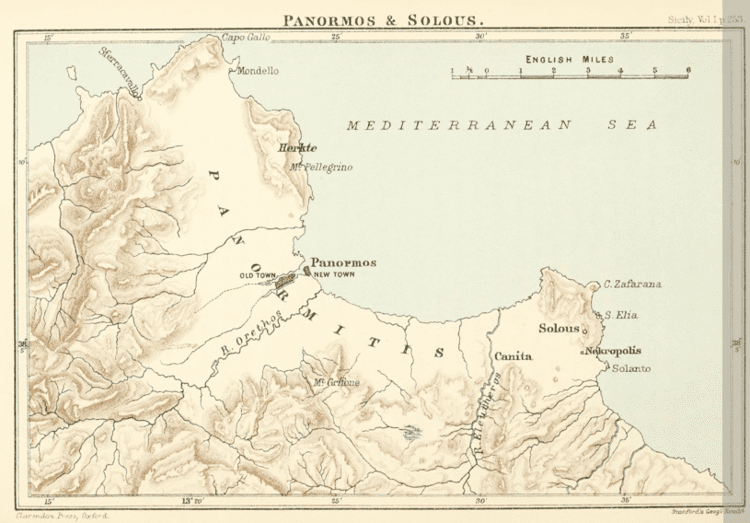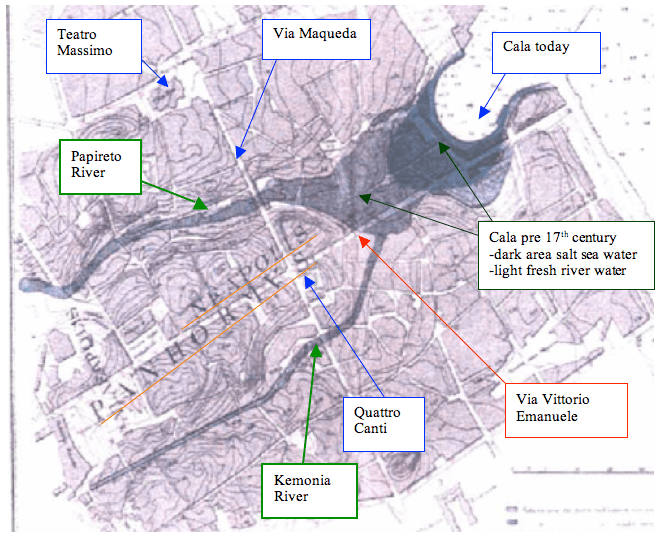Country Italy Population 655,979 (2010) Province Province of Palermo University University of Palermo Area 158.9 km2 | Region Founded 736 BC Mayor Leoluca Orlando (Independent) | |
Points of interest Palazzo dei Normanni, Catacombe dei Cappuccini, Martorana, Cappella Palatina, Church of the Gesu - Palermo | ||
Palermo ( Sicilian: Palermu, Latin: , from Greek: , Panormos, Arabic: ?, Balarm; Phoenician: ????, Ziz) is a city in Insular Italy, the capital of both the autonomous region of Sicily and the Province of Palermo. The city is noted for its history, culture, architecture and gastronomy, playing an important role throughout much of its existence; it is over 2,700 years old. Palermo is located in the northwest of the island of Sicily, right by the Gulf of Palermo in the Tyrrhenian Sea.
Contents
- Map of Palermo
- Visit palermo visit sicily
- History
- Geography
- Landmarks
- Economy
- Palaces and museums
- References
Map of Palermo
The city was founded in 734 BC by the Phoenicians as Ziz (flower). Palermo then became a possession of Carthage, before becoming part of the Roman Republic, the Roman Empire and eventually part of the Byzantine Empire, for over a thousand years. The Greeks named the city Panormus meaning complete port. From 831 to 1072 it was under Arab rule during the Emirate of Sicily when it first became a capital. The Arabs corrupted the Greek name into Balarm, the root for its present-day name. Following the Norman reconquest, Palermo became capital of a new kingdom (from 1130 to 1816), the Kingdom of Sicily. Eventually it would be united with the Kingdom of Naples to form the Two Sicilies until the Italian unification of 1860.
The population of Palermo urban area is estimated by Eurostat to be 855,285, while its metropolitan area is the fifth most populated in Italy with around 1.2 million people. In the central area, the city has a population of around 650,000 people. The inhabitants are known as Palermitans or, poetically, panormiti. The languages spoken by its inhabitants are the Italian language and the Sicilian language, in its Palermitan variation.
Visit palermo visit sicily
Palermo is Sicilys cultural, economic and touristic capital. It is a city rich in history, culture, art, music and food. Numerous tourists are attracted to the city for its good Mediterranean weather, its renowned gastronomy and restaurants, its Romanesque, Gothic and Baroque churches, palaces and buildings, and its nightlife and music. Palermo is the main Sicilian industrial and commercial center: the main industrial sectors include tourism, services, commerce and agriculture. Palermo currently has an international airport, and a significant underground economy. In fact, for cultural, artistic and economic reasons, Palermo was one of the largest cities in the Mediterranean and is now among the top tourist destinations in both Italy and Europe. The city is also going through careful redevelopment, preparing to become one of the major cities of the Euro-Mediterranean area.
Roman Catholicism is highly important in Palermitan culture. The patron saint of the city is Saint Rosalia. Her feast day on July 15 is perhaps the biggest social event in the city. The area attracts significant numbers of tourists each year and is widely known for its colourful fruit, vegetable and fish market at the heart of Palermo, known as the Vucciria.
History

Evidence for human settlement in the area now known as Palermo goes back at least to the Mesolithic period, perhaps around 8000 BC, when a group of cave drawings at nearby Addaura represent a new level in the representation of the human figure. According to Thucydides, the Sicani people arrived from the Iberian Peninsula (perhaps Catalonia). During 734 BC the Phoenicians, a sea trading peoples from the north of ancient Canaan, built a small settlement on the natural harbor of Palermo. Some sources suggest they named the settlement "Ziz." It became one of the three main Phoenician colonies of Sicily, along with Motya and Soluntum. The Greeks, who were the most dominant culture on the island of Sicily due to the powerful city state of Syracuse to the east, instead called the settlement Panormus (????????). Its Greek name means "all-port" (???+?????) and it was named so because of its fine natural harbour. Palermo was then passed on to the Phoenicians descendants and successors, the Carthaginians.

During this period it was a centre of commerce; however a power struggle between the Greeks and the Carthaginians broke out in the form of the Sicilian Wars, causing unrest. It was from Palermo that Hamilcars fleet (which was defeated at the Battle of Himera) was launched. Palermo for a short time became a Greek possession when Pyrrhus of Epirus gained it during the Pyrrhic War period in 276 BC., but was quickly retaken by Carthage. However, as the Romans flooded into Sicily during the First Punic War, the city came under Roman rule during the First Punic War, only three decades later. The period of Roman rule was quite a calm time for Palermo, which grew into an important Roman trade centre.
Geography
Shown above are the thirty five quarters of Palermo: these thirty five neighbourhoods or "quartiere" as they are known, are further divided into eight governmental community boards.
Landmarks
One of the Top tourist attractions in Sicily and points of interest is Palermo. Here you can visit Palazzo dei Normanni, Cappella Palatina, Martorana, Catacombe dei Cappuccini, Teatro Massimo, Palermo Cathedral, Zisa, Mount Pellegrino, Quattro Canti, Mondello beach.
Palermo has a large architectural heritage and is notable for its many Norman buildings.
Economy
Being Sicilys administrative capital, Palermo is home to much of the regions main economic, financial, touristic and commercial life. The city currently hosts an international airport, and Palermos economic growth over the years has brought to the opening of many new businesses and entrepreneurial opportunities. The economy mainly relies on tourism and services, but also commerce, shipbuilding, trade and agriculture. The city, however, still has high unemployment levels, high corruption and a significant black market empire (Palermo being the home of the Sicilian Mafia). Even though the city still suffers from widespread corruption, inefficient bureaucracy and organized crime (Mafia), Palermos crime level has gone down dramatically, unemployment has been decreasing and many new, profitable, strategies (especially regarding tourism) have been introduced, making the city safer and better to live in.
